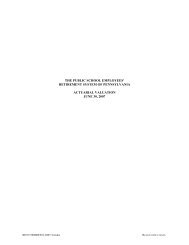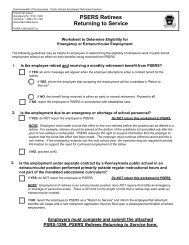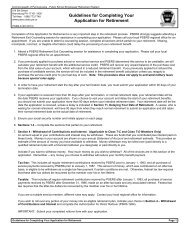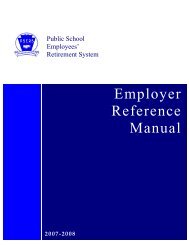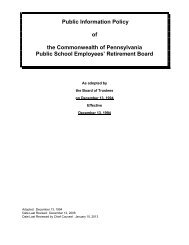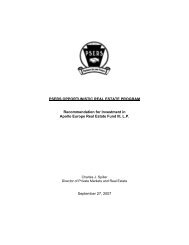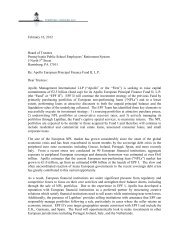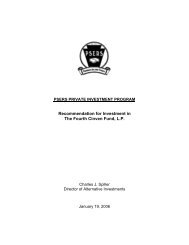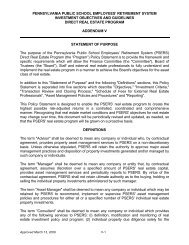a complete copy of the 2012 CAFR Report! - PSERs
a complete copy of the 2012 CAFR Report! - PSERs
a complete copy of the 2012 CAFR Report! - PSERs
You also want an ePaper? Increase the reach of your titles
YUMPU automatically turns print PDFs into web optimized ePapers that Google loves.
FINANCIAL SECTION<br />
Notes to Financial Statements (continued)<br />
actuarial consulting firm sets <strong>the</strong> rates for <strong>the</strong> self-funded<br />
benefits. The HOP maintains reserves for claims that are<br />
incurred but not reported (IBNR) and for claim fluctuation<br />
for <strong>the</strong> self-funded benefit plans. At June 30, <strong>2012</strong> and<br />
2011 PSERS recorded $14,389,000 and $15,394,000,<br />
respectively, in IBNR. The IBNR is included in benefits<br />
payable. The PSERS pension fund assets are not available<br />
to fund or satisfy obligations <strong>of</strong> <strong>the</strong> HOP.<br />
2. Summary <strong>of</strong> Significant Accounting Policies<br />
(A) Basis <strong>of</strong> Accounting<br />
The financial statements <strong>of</strong> <strong>the</strong> System are prepared on<br />
<strong>the</strong> accrual basis <strong>of</strong> accounting under which expenses<br />
are recorded when <strong>the</strong> liability is incurred, revenues<br />
are recorded in <strong>the</strong> accounting period in which <strong>the</strong>y are<br />
earned and become measurable, and investment purchases<br />
and sales are recorded as <strong>of</strong> <strong>the</strong>ir trade date. Member<br />
and employer contributions are recognized in <strong>the</strong> period<br />
for which employees’ salaries are reported. Benefits and<br />
refunds are recognized when due and payable in accordance<br />
with <strong>the</strong> terms <strong>of</strong> <strong>the</strong> plan.<br />
The accounting and reporting policies <strong>of</strong> <strong>the</strong> System<br />
conform to accounting principles generally accepted in<br />
<strong>the</strong> United States <strong>of</strong> America (GAAP). The preparation<br />
<strong>of</strong> financial statements in conformity with GAAP requires<br />
management to make estimates and assumptions that affect<br />
<strong>the</strong> reported amounts <strong>of</strong> assets and liabilities and disclosure<br />
<strong>of</strong> contingent assets and liabilities at <strong>the</strong> date <strong>of</strong> <strong>the</strong> financial<br />
statements and <strong>the</strong> reported amounts <strong>of</strong> additions and<br />
deductions in plan net assets during <strong>the</strong> reporting period.<br />
Actual results could differ from those estimates.<br />
(B) Investments<br />
The System’s investments are reported at fair value. Fair<br />
value is <strong>the</strong> amount that <strong>the</strong> System can reasonably expect<br />
to receive for an investment in a current sale between a<br />
willing buyer and a willing seller, that is, o<strong>the</strong>r than in a<br />
forced or liquidation sale. Short-term securities are carried<br />
at cost, which approximates fair value, unless <strong>the</strong>y have<br />
published market prices or quotations from national<br />
securities exchanges or securities pricing services, in<br />
which case <strong>the</strong>y are valued at <strong>the</strong> published market price.<br />
Fixed income securities and common and preferred stocks<br />
are generally valued based on published market prices and<br />
quotations from national securities exchanges or securities<br />
pricing services. Securities which are not traded on a<br />
national securities exchange are valued by <strong>the</strong> respective<br />
fund manager or o<strong>the</strong>r third parties based on similar sales.<br />
Directly-owned real estate investments are primarily<br />
valued based on appraisals performed by independent<br />
appraisers and, for properties not appraised, <strong>the</strong> present<br />
value <strong>of</strong> <strong>the</strong> projected future net income stream is used.<br />
Real estate owned investments are reported net <strong>of</strong> related<br />
debt borrowed against <strong>the</strong> market value <strong>of</strong> <strong>the</strong> property.<br />
As <strong>of</strong> June 30, <strong>2012</strong> and 2011, $132,000,000 in line <strong>of</strong><br />
credit advances were netted against <strong>the</strong> related property<br />
valuation. The line <strong>of</strong> credit balance is due on March 9,<br />
2015. The line is payable at an interest rate equivalent to<br />
<strong>the</strong> lender’s commercial paper rate plus 75 basis points and<br />
is collateralized by certain fixed income investments <strong>of</strong> <strong>the</strong><br />
System.<br />
For alternative investments which include private equity,<br />
private debt, venture capital and equity real estate<br />
investments where no readily ascertainable market value<br />
exists, management, in consultation with <strong>the</strong> general<br />
partner and investment advisors, has determined <strong>the</strong> fair<br />
values for <strong>the</strong> individual investments based upon <strong>the</strong><br />
partnership’s most recent available financial information.<br />
Futures contracts, foreign exchange contracts, and options<br />
are marked-to-market daily based on published market<br />
prices and quotations from national securities exchanges<br />
or securities pricing services. The changes in market value<br />
are recognized as part <strong>of</strong> net appreciation/depreciation in<br />
<strong>the</strong> fair value <strong>of</strong> investments. Initial margin requirements<br />
for such financial instruments are provided by investment<br />
securities pledged as collateral or by cash.<br />
Collective trust fund investments (CTF) consist primarily<br />
<strong>of</strong> domestic and international institutional funds. The<br />
funds generally do not pay interest or dividends to<br />
shareholders and reinvest all income earned on securities<br />
held by <strong>the</strong> fund. The fair value <strong>of</strong> CTF is based on <strong>the</strong><br />
reported share value <strong>of</strong> <strong>the</strong> respective fund. CTF are<br />
managed by state chartered banks for which various<br />
state banking departments have regulatory oversight and<br />
investment advisors for which regulatory agencies such as<br />
<strong>the</strong> Securities and Exchange Commission have regulatory<br />
oversight. Investments that are not subject to this oversight<br />
are subject to annual independent audits.<br />
In accordance with PSERS’ investment guidelines, cash<br />
collateral from securities loaned is invested in one <strong>of</strong><br />
two collateral investment pools, <strong>the</strong> first <strong>of</strong> which is<br />
denominated in U.S. dollars (USD) and <strong>the</strong> second in<br />
Euros. The USD pool is invested entirely in overnight<br />
repurchase agreements carried at amortized cost which<br />
approximates fair value. The Euro pool is invested in assetbacked<br />
floating rate notes which are marked-to-market<br />
daily based on published market prices and quotations<br />
from national securities exchanges or securities pricing<br />
PAGE 45




